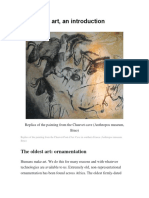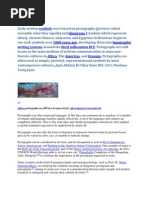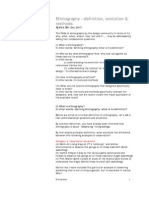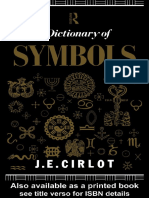Pictograph
Pictograph
Uploaded by
Ashtrien JieCopyright:
Available Formats
Pictograph
Pictograph
Uploaded by
Ashtrien JieCopyright
Available Formats
Share this document
Did you find this document useful?
Is this content inappropriate?
Copyright:
Available Formats
Pictograph
Pictograph
Uploaded by
Ashtrien JieCopyright:
Available Formats
Pictogram
Pictogram
A pictograph[1] , also called pictogram(me), is an ideogram that conveys its meaning through its pictorial resemblance to a physical object. Pictographs are often used in writing and graphic systems in which the characters are to considerable extent pictorial in appearance. Pictography is a form of writing which uses representational, pictorial drawings. It is a basis of cuneiform and, to some extent, hieroglyphic writing, which uses drawings also as phonetic letters or determinative rhymes.
Historical
Early written symbols were based on pictographs (pictures which resemble what they signify) and ideograms (symbols which represent ideas). Ancient Chinese, Sumerian, and Egyptian civilizations began to use such symbols over 5000 years ago, developing them into logographic writing systems around the third millennium BCE. Pictographs are still in use as the main medium of written communication in some non-literate cultures in Africa, The Americas, and Oceania. Pictographs are often used as simple, pictorial, representational symbols by most contemporary cultures. Pictographs can often transcend languages in that they can communicate to speakers of a number of tongues and language families equally effectively, even if the languages and cultures are completely different. This is why road signs and similar pictographic material are often applied as global standards expected to be understood by nearly all. Pictographs can also take the form of diagrams to represent statistical data by pictorial forms, and can be varied in color, size, or number to indicate change. Pictographs can be considered an art form, and are designated as such in Pre-Columbian art, Native American art, and Painting in the Americas before Colonization. One example of many is the Rock art of the Chumash people, part of the Native American history of California. In 2011, UNESCO World Heritage adds to its list a new site "Petroglyphs Complexes of the Mongolian Altai, Mongolia"[2] to celebrate the importance of the pictograms engraved in rocks. Some scientists in the field of neuropsychiatry and neuropsychology, such as Prof. Dr. Mario Christian Meyer, are studying the symbolic meaning of indigenous pictograms and petroglyphs,[3] aiming to create new ways of communication between native people and modern scientists to safeguard and valorize their cultural diversity.[4]
Ojibwa pictographs on cliff-face at Agawa Rock, Lake Superior Provincial Park
Modern use
Pictographs remain in common use today, serving as pictorial, representational signs, instructions, or statistical diagrams. Because of their graphical nature and fairly realistic style, they are widely used to indicate public toilets, or places such as airports and train stations. A standard set of pictographs was defined in the international standard ISO 7001: Public Information Symbols. Another common set of pictographs are the laundry symbols used on clothing tags and chemical hazard labels. Pictographic writing as a modernist poetic technique is credited to Ezra Pound, though French surrealists accurately credit the Pacific Northwest American Indians of Alaska who introduced writing, via totem poles, to North America.[5] Contemporary artist Xu Bing created Book from the Ground [6], a universal language made up of pictogram collected from around the world. A Book from the Ground chat program has been exhibited in museums and
Pictogram galleries internationally. There is a Book from the Ground Wiki [7] currently in development that needs public participation in development. The wiki will be a continually growing database of pictogram used in the chat program, books, signs etc.
Native American Pictographs from the Great Gallery, Horseshoe Canyon, Canyonlands National Park
Sample National Park Service pictographs
Pictograph from 1510 telling a story of coming of missionaries to Hispaniola
Water, rabbit, deer pictographs on a replica of an Aztec Stone of the Sun
British Rail passenger safety pictographs at the end of the platform at Meols railway station
A pictograph warning against swimming because of crocodiles at the Australia Zoo.
"No Dogs!" sign in Spain. The dog illustration is a pictograph. The red circle and bar is an ideogram representing the idea of "no" or "not allowed."
The top traffic sign warns people of horses and riders.
A Recycling symbol.
Pictogram
Notes
[1] Gove, Philip Babcock. (1993). Webster's Third New International Dictionary of the English Language Unabridged. Merriam-Webster Inc. ISBN 0-87779-201-1. [2] http:/ / whc. unesco. org/ en/ list/ 1382 [3] http:/ / unesdoc. UNESCO. org/ images/ 0006/ 000678/ 067843F. pdf [4] http:/ / www. pisad. bio. br/ artigos/ amazonupclose_outoftheforest. pdf [5] Reed 2003, p. xix [6] http:/ / www. bookfromtheground. com [7] http:/ / www. bookfromtheground. com/ wiki
References
Reed, Ishmael (2003). From Totems to Hip-Hop: A Multicultural Anthology of Poetry Across the Americas, 1900-2002, Ishmael Reed, ed. ISBN 1-56025-458-0.
External links
Pictogram & Communication: About 1,500 practial pictograms based on Design principles of pictorial symbols for communication support(JIS T 0103:2005) (http://pic-com.jp/) CAPL:The Culturally Authentic Pictorial Lexicon, photographic illustrations of objects for multiple languages (http://capl.washjeff.edu/) Pictogram Encyclopedia, The collection site of more than 500 pictograms, Pictograms are categorized, and easy to find unique pictogram (http://pictopedia.jp/eng/) Pictopen (http://www.pictopen.com) - Modern Pictographic Writing
Article Sources and Contributors
Article Sources and Contributors
Pictogram Source: http://en.wikipedia.org/w/index.php?oldid=446438708 Contributors: 1000Faces, 16@r, ABoerma, Agradman, Aintsemic, AlainV, Alerante, Amitauti, Anakolouthon, Ancheta Wis, AndreasJS, Andrew Dow, ArmadilloProcess, Avjoska, Azumanga1, Babylonian Armor, Bastianperrot, Bejnar, Bellenion, Big iron, Bluedillygal, BonsaiViking, Bxj, CALR, Captain-tucker, Ceranthor, Charles Matthews, Circeus, Civil Engineer III, Clockface10, Ctanggg, Ctangggg, Cybercobra, DVD R W, Davemon, DavidHo Picto, Dekimasu, Dger, Dpv, EagleFan, Eastlaw, Edwy, Ellywa, Emperorbma, Ericd, Everyme, Floddinn, Fpenteado, Frecklefoot, Fyyer, Gaius Cornelius, George The Dragon, Ghirlandajo, Glenn, Green Giant, Gsklee, Gurch, Hajatvrc, HalfShadow, HamburgerRadio, Heimhenge, Heqs, Hikingbert, Hyacinth, Ikiroid, Ink mathematics, Iranway, It's-is-not-a-genitive, Ixfd64, JForget, Jacobko, James Arboghast, Japanese Searobin, Jauhienij, Joexmanx10, Johnbod, Josephprymak, Joshua1995, Kablammo, Kaicarver, Karriaagzh, King Wagga, KnightRider, Koavf, Kvdveer, Kwamikagami, Linkofazeroth, Look2See1, Looxix, MacedonianBoy, Mailer diablo, Malbi, Mandarax, Mardochaios, Marino-slo, Martarius, MartinHarper, Mdd, Mervyn, Milan Kerlger, Mild Bill Hiccup, Modernist, Nate Silva, NeilN, Neptune5000, Ntsimp, Olivier, Oliwan, Patrick, Patricknoddy, Paxse, PericlesofAthens, Phasmatisnox, Pietaster, Piotrus, Pixelface, Prolog, PuzzletChung, Radon210, Ran, Reddi, Redvers, Rich Farmbrough, Rogper, Rosenknospe, Ross Monroe, Roux-HG, SEWilco, Sardanaphalus, Sarregouset, Seaphoto, SineWave, Squidley, Stijn Vermeeren, Susiemorgan, T-bomb, Tarquin, Teledildonix314, Tempodivalse, Tide rolls, Tillman, Timwi, Tkgd2007, Tregoweth, TrueBox, Unyoyega, Utahcamera, Vg31416, WikHead, Wikid77, Wikmontmartre18, Woohookitty, Wshun, Zack wadghiri, Zaui, Zondor, 141 anonymous edits
Image Sources, Licenses and Contributors
File:Agawa Rock, panel VIII.jpg Source: http://en.wikipedia.org/w/index.php?title=File:Agawa_Rock,_panel_VIII.jpg License: Creative Commons Attribution-Sharealike 3.0 Contributors: User:Dger Image:GreatGalleryedit.jpg Source: http://en.wikipedia.org/w/index.php?title=File:GreatGalleryedit.jpg License: Creative Commons Attribution-ShareAlike 3.0 Unported Contributors: Scott Catron Image:National Park Service sample pictographs.svg Source: http://en.wikipedia.org/w/index.php?title=File:National_Park_Service_sample_pictographs.svg License: Public Domain Contributors: Tkgd2007 Image:Piktograf1.png Source: http://en.wikipedia.org/w/index.php?title=File:Piktograf1.png License: Public Domain Contributors: Man vyi, Mattes, Piotrus, Santosga, Till.niermann, 2 anonymous edits Image:Water,Rabbit,Deer.jpg Source: http://en.wikipedia.org/w/index.php?title=File:Water,Rabbit,Deer.jpg License: Creative Commons Attribution-Sharealike 2.5 Contributors: en:User:Ancheta Wis Image:Railway pictograms.jpg Source: http://en.wikipedia.org/w/index.php?title=File:Railway_pictograms.jpg License: Creative Commons Attribution 3.0 Contributors: Redvers Image:Alligator pictogram.jpg Source: http://en.wikipedia.org/w/index.php?title=File:Alligator_pictogram.jpg License: GNU Free Documentation License Contributors: Phasmatisnox Image:Perros No.svg Source: http://en.wikipedia.org/w/index.php?title=File:Perros_No.svg License: Public Domain Contributors: Constantin Gro (Connum at de.wikipedia) Image:road-sign-horse.jpg Source: http://en.wikipedia.org/w/index.php?title=File:Road-sign-horse.jpg License: Public Domain Contributors: Original uploader was Matt.whitby at en.wikipedia Image:Recycling_symbol.svg Source: http://en.wikipedia.org/w/index.php?title=File:Recycling_symbol.svg License: Public Domain Contributors: Krdan Image:MUTCD_W3-1.svg Source: http://en.wikipedia.org/w/index.php?title=File:MUTCD_W3-1.svg License: Public Domain Contributors: Kazuya35, Overpush, J, 5 anonymous edits
License
Creative Commons Attribution-Share Alike 3.0 Unported http:/ / creativecommons. org/ licenses/ by-sa/ 3. 0/
You might also like
- ModifiedCRLA G2 Scoresheet v1-1Document45 pagesModifiedCRLA G2 Scoresheet v1-1Nelma ArnaizNo ratings yet
- Mitchell, W.T.J. - The Pictorial TurnDocument27 pagesMitchell, W.T.J. - The Pictorial TurnMadi Manolache83% (24)
- American Think Level 1 Combo B With Online WorkbDocument2 pagesAmerican Think Level 1 Combo B With Online WorkbChristiam Herrera Calero50% (4)
- German and Japanese SymbolsDocument35 pagesGerman and Japanese Symbolsmamamambo6568No ratings yet
- Paleolithic ArtDocument35 pagesPaleolithic ArtJorge0% (1)
- The Graphics of Communication: Exploring the Graphic Arts and DesignFrom EverandThe Graphics of Communication: Exploring the Graphic Arts and DesignRating: 5 out of 5 stars5/5 (1)
- What Is Design?: An Overview of Design in Context from Prehistory to 2000 A.D.From EverandWhat Is Design?: An Overview of Design in Context from Prehistory to 2000 A.D.No ratings yet
- Report Generator User GuideDocument1,348 pagesReport Generator User GuideVivaCharlesNo ratings yet
- Instructions & Document Matching Form: Applicant Detail Reference Number #971906Document1 pageInstructions & Document Matching Form: Applicant Detail Reference Number #971906Anonymous I7C9AxodANo ratings yet
- Symbols Ideograms 5000 Years Ago Logographic Writing Systems Third Millennium BCE Africa Americas OceaniaDocument2 pagesSymbols Ideograms 5000 Years Ago Logographic Writing Systems Third Millennium BCE Africa Americas OceaniaWaqas AliNo ratings yet
- Historical: Ojibwa Lake Superior Provincial Park MishipeshuDocument4 pagesHistorical: Ojibwa Lake Superior Provincial Park MishipeshuChristian ConsignaNo ratings yet
- History of Visual CommunicationDocument6 pagesHistory of Visual Communicationmuhammaddanish120gbNo ratings yet
- Communication History and TechnologyDocument39 pagesCommunication History and TechnologyNina Arra RiveraNo ratings yet
- Akash Priyan 20 Rahul Haridas 26: Vidya Vikas College of Arts, Science, Commerce, BMM & BMS FybmmDocument27 pagesAkash Priyan 20 Rahul Haridas 26: Vidya Vikas College of Arts, Science, Commerce, BMM & BMS FybmmRahul HaridasNo ratings yet
- Books Before Typography A Primer of Information About the Invention of the Alphabet and the History of Book-Making up to the Invention of Movable Types Typographic Technical Series for Apprentices #49From EverandBooks Before Typography A Primer of Information About the Invention of the Alphabet and the History of Book-Making up to the Invention of Movable Types Typographic Technical Series for Apprentices #49No ratings yet
- Children Literature 4Document10 pagesChildren Literature 4milanesasNo ratings yet
- Topic: History of Communication Skills: Addressed By: Saira BanoDocument29 pagesTopic: History of Communication Skills: Addressed By: Saira BanoRajaA214No ratings yet
- Typography in Graphic DesignDocument29 pagesTypography in Graphic DesignGabriela RomariaNo ratings yet
- Different Methods For StorytellingDocument4 pagesDifferent Methods For Storytellingsiddharth joshiNo ratings yet
- Graffiti World Street Art FROM FIVE CONTINENTSDocument189 pagesGraffiti World Street Art FROM FIVE CONTINENTSHKM (Carnalito)91% (11)
- Q1 History of IllustrationDocument7 pagesQ1 History of Illustrationz73599496No ratings yet
- Poptropica Teaching GuideDocument4 pagesPoptropica Teaching GuideAbrams Books100% (1)
- Comics: Investigate the History and Technology of American CartooningFrom EverandComics: Investigate the History and Technology of American CartooningNo ratings yet
- The Shaman in Transformation Pose A Study of The Theme of Rulership in Olmec ArtDocument19 pagesThe Shaman in Transformation Pose A Study of The Theme of Rulership in Olmec Artthesubte100% (4)
- History of MediaDocument47 pagesHistory of MediaAhmed NasserNo ratings yet
- Lesson 7 Art in Early Civilizations & Lesson 8 Art in Emerging Europe PDFDocument16 pagesLesson 7 Art in Early Civilizations & Lesson 8 Art in Emerging Europe PDFKate AlbesNo ratings yet
- Ge 3.contemporary World.m2t7Document15 pagesGe 3.contemporary World.m2t7Tian XianNo ratings yet
- Visibility Matters: Diagrammatic Renderings of Human Evolution and Diversity in Physical, Serological and Molecular AnthropologyDocument14 pagesVisibility Matters: Diagrammatic Renderings of Human Evolution and Diversity in Physical, Serological and Molecular AnthropologyHannah GoldebrgNo ratings yet
- History of CommunicationDocument41 pagesHistory of CommunicationAmeya Bhagat100% (1)
- History of Media Notes - Unit 1Document7 pagesHistory of Media Notes - Unit 1ShubhangiNo ratings yet
- Pettersson Rune ID6 Predecessors PioneersDocument268 pagesPettersson Rune ID6 Predecessors Pioneerscristina santosNo ratings yet
- History of Comics (Report)Document17 pagesHistory of Comics (Report)Hammad9029100% (3)
- Mark Rothko-Heritage, EnvironmentDocument33 pagesMark Rothko-Heritage, EnvironmentchnnnnaNo ratings yet
- JMC 14, Block-1Document54 pagesJMC 14, Block-1Gopal pandeyNo ratings yet
- Unit-5-Art-HistoryDocument8 pagesUnit-5-Art-HistoryrosalinamontanoNo ratings yet
- Illustration - WikipediaDocument31 pagesIllustration - Wikipediajeremiahdogodzi2000No ratings yet
- Ethnography QuestionsDocument8 pagesEthnography Questionsrohimah_rejabNo ratings yet
- Review of Related LiteratureDocument10 pagesReview of Related LiteratureJhansen Feliciano /JHAZPRINT/No ratings yet
- Subjects and Narratives in ArchaeologyFrom EverandSubjects and Narratives in ArchaeologyRuth M. Van DykeNo ratings yet
- Jaguar Symbolism and Me So American ElitesDocument15 pagesJaguar Symbolism and Me So American ElitesMarcy NortonNo ratings yet
- Dictionary of Symbols by J. E. CirlotDocument507 pagesDictionary of Symbols by J. E. CirlotRJ100% (5)
- Module 11 Week11Document25 pagesModule 11 Week11Lovelyn MaristelaNo ratings yet
- Berman, Judith C., Bad Hair Days in The Paleolithic - Modern (Re) Constructions of The Cave ManDocument18 pagesBerman, Judith C., Bad Hair Days in The Paleolithic - Modern (Re) Constructions of The Cave ManSaurav BhagatNo ratings yet
- Download ebooks file Introduction to Mythology Contemporary Approaches to Classical and World Myths 4th Edition Eva M. Thury all chaptersDocument40 pagesDownload ebooks file Introduction to Mythology Contemporary Approaches to Classical and World Myths 4th Edition Eva M. Thury all chaptersodlumbambu100% (4)
- CatDocument15 pagesCatMohammad SalemyNo ratings yet
- Nature On Display in American Zoos: Preliminary TestDocument9 pagesNature On Display in American Zoos: Preliminary TesthungNo ratings yet
- Berman Bad Hair DayDocument17 pagesBerman Bad Hair DaymadalinaNo ratings yet
- Art Culture InsectsDocument31 pagesArt Culture InsectsPamela ZechlinskiNo ratings yet
- Module Gec5 Midterm and FinalsDocument34 pagesModule Gec5 Midterm and FinalsLindsay LabagnoyNo ratings yet
- Reviewwr History of Visual ComDocument3 pagesReviewwr History of Visual Comnidarosales888No ratings yet
- Rhetoric in The Visual Arts - Ernest J. EnchelmayerDocument21 pagesRhetoric in The Visual Arts - Ernest J. EnchelmayerLuis RibeiroNo ratings yet
- Animation of FolktalesDocument33 pagesAnimation of FolktalesAjewole Eben Tope100% (1)
- The Serpent Column: A Cultural Biography Paul Stephenson All Chapters Instant DownloadDocument55 pagesThe Serpent Column: A Cultural Biography Paul Stephenson All Chapters Instant Downloadmahadcolakdx100% (1)
- Scientific Illustration in The Eighteenth CenturyDocument21 pagesScientific Illustration in The Eighteenth CenturycosmosomNo ratings yet
- From Olympus To Camelot The World of European Mythology - LeemingDocument225 pagesFrom Olympus To Camelot The World of European Mythology - Leemingnevernevernever100% (1)
- Table of Contents Format Term PaperDocument6 pagesTable of Contents Format Term Paperafmzbzdvuzfhlh100% (1)
- Ensayos de Becas de EnfermeríaDocument6 pagesEnsayos de Becas de Enfermeríaafmoigofu100% (2)
- Alfabeto para NiñosDocument108 pagesAlfabeto para NiñosLeslie GordilloNo ratings yet
- 2751 Bunny Pattern Binder 0Document9 pages2751 Bunny Pattern Binder 0tkp07tkpNo ratings yet
- Havard Quick GuideDocument3 pagesHavard Quick GuideLílian FrançaNo ratings yet
- Unit-I: Example ExplainedDocument27 pagesUnit-I: Example ExplainedDinesh SrinivasNo ratings yet
- Grade 10 - Unit 06Document7 pagesGrade 10 - Unit 06UmayangaNo ratings yet
- Colorado Zip Code Map PDFDocument2 pagesColorado Zip Code Map PDFTanikaNo ratings yet
- Ejercicios Resueltos de SQL en ORACLE Con El Esquema HR en ESPAÑOLDocument9 pagesEjercicios Resueltos de SQL en ORACLE Con El Esquema HR en ESPAÑOLJavier Armando Valladares Lozano100% (4)
- Post PHPDocument160 pagesPost PHPArrey ValeryNo ratings yet
- NLC WK 5Document8 pagesNLC WK 5HazelBitagaNo ratings yet
- Read PDF The 90-Day Home Workout Plan: A Total Body Fitness Program For Weight Training, Cardio, Core Stretching - OnlineDocument1 pageRead PDF The 90-Day Home Workout Plan: A Total Body Fitness Program For Weight Training, Cardio, Core Stretching - OnlineGokula Krishnan.DNo ratings yet
- Curriculum Pedagogy Book Final PDFDocument1 pageCurriculum Pedagogy Book Final PDFSobia TabassumNo ratings yet
- English: Quarter 1 - Module 2: Using Conventions in Citing SourcesDocument30 pagesEnglish: Quarter 1 - Module 2: Using Conventions in Citing SourcesAljerr LaxamanaNo ratings yet
- SWPD Practical ListDocument2 pagesSWPD Practical ListRealwax Industries100% (1)
- Raz La13 MybodyDocument12 pagesRaz La13 MybodylanlanNo ratings yet
- What Is WritingDocument1 pageWhat Is WritingIka ApriliaNo ratings yet
- Kreatív Írás Angolul CsomagDocument30 pagesKreatív Írás Angolul CsomagANFieldsNo ratings yet
- Harvard Referencing Style - Curtin Style GuideDocument8 pagesHarvard Referencing Style - Curtin Style GuidesandunkcNo ratings yet
- Pendaftaran Bem Uthm Konvo 2018Document10 pagesPendaftaran Bem Uthm Konvo 2018Amir ZarifNo ratings yet
- Catalogos de Ser NecesarioDocument26 pagesCatalogos de Ser NecesarioSofia D'AlessandroNo ratings yet
- Math Unit 2 Grade 3 Lesson 29 31Document158 pagesMath Unit 2 Grade 3 Lesson 29 31Arlene SonNo ratings yet
- Jammu & KashmirDocument38 pagesJammu & KashmirRishi WadhwaniNo ratings yet
- Fiction Book Kindle Formatting Template For Ebook Publishing School 2.0Document17 pagesFiction Book Kindle Formatting Template For Ebook Publishing School 2.0G DriveNo ratings yet
- Unicode Standard RunicDocument3 pagesUnicode Standard RunicJasonNo ratings yet
- Tracing Genset Layout 1Document1 pageTracing Genset Layout 1zaccNo ratings yet

























































































